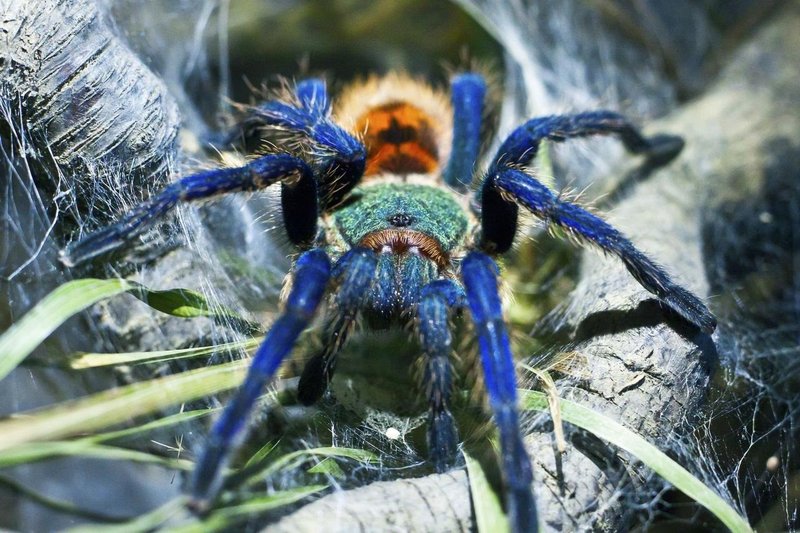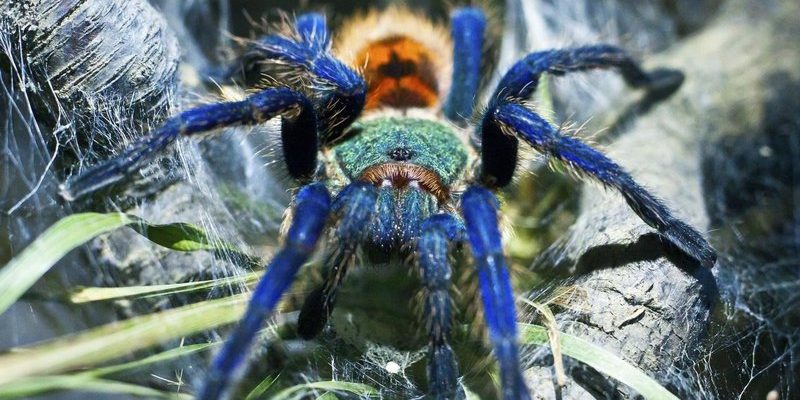
Let’s break it down together, like we’re sitting at a cozy café sipping on our drinks. The Greenbottle Blue Tarantula, or *Chromatopelma cyaneopubescens*, is often lauded for its vibrant hues and fascinating behavior. But with such a captivating appearance, it’s easy to question whether they pack a bite or if they’ve got a temper to match their looks. So, what’s the real deal?
In this article, we’ll explore the temperament, behavior, and potential dangers of the Greenbottle Blue Tarantula. By the end, you’ll have a clearer picture of whether this particular spider should be revered or feared.
Understanding the Greenbottle Blue Tarantula
The Greenbottle Blue Tarantula is like the rock star of the tarantula world. Found primarily in the forests of Central and South America, particularly in countries like Costa Rica and Panama, it has stunning iridescent blue legs and vibrant greenish-yellow hues on its body. It’s not just a pretty face. This tarantula is also known for its interesting behaviors and habitat preferences.
In the wild, these spiders often make their homes in burrows, using silk to line the inside. This gives them a cozy spot to retreat to when they feel threatened. Imagine coming home after a long day to your own soft, safe bed—this is what they do with their burrows. Their natural habitat is essential for their survival, and it gives us a glimpse into why they behave the way they do.
Many enthusiasts keep Greenbottle Blue Tarantulas as pets, drawn by their beauty and relatively manageable care needs compared to other exotic species. However, owning one requires understanding their basic instincts and needs, which we will dive into shortly.
Are Greenbottle Blue Tarantulas Dangerous?
Here’s the thing: the term “dangerous” can mean different things to different people. If you’re talking about the Greenbottle Blue Tarantula, it’s generally considered not dangerous to humans. Their venom is mild and typically causes only minor irritation, similar to a bee sting. So if you happen to get bitten—which is pretty rare—they’re unlikely to send you running to the hospital.
Still, it’s essential to remember that all spiders can bite if they feel threatened. Greenbottle Blue Tarantulas are generally skittish and prefer to avoid confrontation. Think of them as introverts at a party—if they can sneak away unnoticed, they will. On the rare occasion that they do bite, the reaction can include redness and swelling, but nothing too serious.
For those who are particularly sensitive or allergic to insect bites, it’s always good to err on the side of caution. But for most people, taking proper care of this tarantula can lead to a beautiful yet harmless pet.
Behavior: Are They Aggressive?
When it comes to aggression, the Greenbottle Blue Tarantula may surprise you. They aren’t aggressive per se, but they do have a few tricks up their sleeves to defend themselves. If they feel cornered, they might display some defensive posturing, such as raising their front legs or producing a hissing sound by rubbing their body parts together. This can be intimidating, but it’s more of a warning than a prelude to an attack.
In the comfort of their enclosure, these tarantulas are actually quite fascinating to observe. They often engage in interesting behaviors, like webbing up their surroundings or climbing to high spots in their enclosures. This energy isn’t aggression; it’s just them being curious about their world. Their active demeanor can be captivating and is part of what makes them popular in the pet trade.
If you’re considering bringing one into your home, it’s best to handle them with care. Make sure to read up on how to properly interact with them to avoid any mishaps.
Handling Your Greenbottle Blue Tarantula
If you decide to keep a Greenbottle Blue Tarantula, handling it needs to be done thoughtfully. While they aren’t known for being aggressive, they can get stressed out easily. In handling, it’s essential to provide them a safe space and minimize sudden movements that could startle them.
When you approach your tarantula, try using a gentle touch. A soft, open palm is typically the best way to go—think about how you’d gently coax a cat out from under the bed. Place the palm flat and allow the tarantula to walk onto it voluntarily. This way, they’ll feel more in control of the situation, which can lower their stress levels.
And just remember: if they want to retreat back into their burrow or hide, let them! Respecting their natural instincts is crucial. It’s about building trust over time, not forcing interaction.
Caring for Your Greenbottle Blue Tarantula
Caring for a Greenbottle Blue Tarantula means mimicking its natural environment as closely as possible. They thrive in warm, humid conditions, so creating the right habitat is key. Ideally, their enclosure should be filled with substrate like coconut fiber or peat moss, allowing them to burrow and feel secure.
You’ll also want to keep their space clean and provide fresh water regularly. A small, shallow dish will do the trick, but make sure it’s not deep enough for them to drown. And don’t forget to mist their habitat occasionally to maintain humidity levels. Picture it like caring for a small garden—you need to keep the environment just right for it to flourish.
Feeding is another essential aspect of their care. Greenbottle Blue Tarantulas are carnivorous and enjoy a diet of insects like crickets or mealworms. Just like you would pick out fresh veggies for a salad, you’ll need to make sure their meals are healthy and appropriate. Try to feed them about once a week, but always keep an eye on how much they’re consuming.
Why Knowing the Truth Matters
Understanding the nature of the Greenbottle Blue Tarantula isn’t just about knowing if they’re dangerous or aggressive. It’s about grasping the intricacies of a creature that plays a role in its ecosystem. These spiders help control insect populations, contributing to a healthier environment. When we appreciate them for what they are, we gain a deeper respect for the natural world.
This knowledge is especially crucial for those considering getting a tarantula as a pet. Misunderstandings about these creatures can lead to fear, mistreatment, or even abandonment. By informing ourselves, we can make more compassionate choices in how we care for them.
So, whether you’re a seasoned enthusiast or just curious about these fascinating creatures, knowing the facts will help you appreciate their beauty without undue fear.
In conclusion, the Greenbottle Blue Tarantula is a stunning part of the spider family that captures attention for both its beauty and behavior. While they’re not a threat to humans, they do warrant respect and understanding. With appropriate care and interaction, they can be wonderful companions in the arachnid world.

